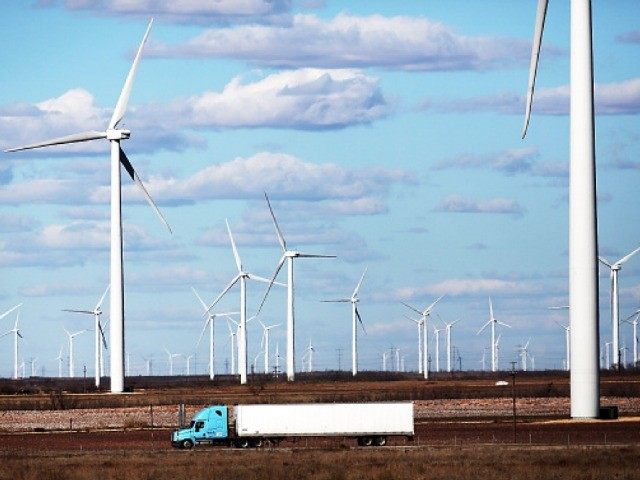BIG SPRING, TEXAS – A leading wind energy association argues that a “wind rush” is on and Texas leads the nation in total workforce growth. More than 24,000 jobs and counting are directly attributable to the rising industry in the state amid a continuance of federal tax credits that is expect to boost new growth over the next four years.
Figures released by the American Wind Energy Association (AWEA), a Washington D.C.-based trade organization, commends Texas for not only securing the highest rate of job growth across the country, but also as the recipient of the most capital investment over the past decade, garnering $32.7 billion of the estimated national total of $128 billion. California lags behind Texas with $11.9 billion, while Iowa, Illinois and Oklahoma combined saw $29.1 billion in similar investments. The association’s report credits nearly every population center in the state with holding active wind-related manufacturing facilities by the end of 2015, with plants across the Permian Basin, Amarillo, DFW, Houston and Central Texas. The Lone Star State’s full capacity is currently capable of generating more than 10,000 megawatts. Not all electricity is locally sourced, however. Colorado’s wind farms have at times contributed roughly a quarter of the electricity to Texas’ grid to meet growing demand.
The largest wind farm in Texas was built in Roscoe, roughly 50 miles west of Abilene on the Interstate 20 corridor, completed in 2009. The location, developed by E.ON Climate and Renewables, boasts a 780 megawatt capacity with more than 620 turbines, according to Reuters.
The energy trade group commends a bipartisan tax credit agreement inked in December 2015 that secured “several years of predictable policies that encourage private investment in wind energy”, according to a recent statement. The Production Tax Credit and alternate Investment Tax Credit was extended through 2016 as is, yet would decrease in value to 80 percent in 2017; 60 percent for 2018; and 40 percent by 2019. The current federal credit is set at 2.3 cents per kilowatt-hour for electricity generated that hits a power grid.
Big Spring, Texas (40 miles east of Midland) lays claim to one of the earliest contemporary wind farm developments in the state with infrastructure completed in 2008, now capable of producing 250 megawatts. The Big Spring Economic Development Corporation notes that new development has spurred area educational institutions to cater to the developing workforce needs while the local economic base has diversified in general. The matter of precise, sustainable job growth may not match the AWEA’s wholly rosy message, however.
“You can have a couple hundred construction employees to build a new farm within a six month to year period, but less than 10 percent of those jobs may stick around after completion,” Terry Wegman, Executive Director of the local economic development board told Breitbart Texas. But while the bulk of new farm jobs come and go, existing farms in the area have been attractive to logistics-focused companies looking to relocate. Wegman notes that as infrastructure for wind farms continue to build out, the demand for long term turbine service jobs in the immediate vicinity will continue to grow.
A separate challenge has been presented to local economies and taxing jurisdictions to maintain a relatively predictable level of revenue from the farms. Big Spring has offered payments in lieu of tax (PILT) agreements, which have shown recent success in five area farms. Taxing jurisdictions and farms typically agree to a flat dollar amounts to be paid over a 10 year period, based on total potential electric output.
Nationwide, wind power accounts for 88,000 jobs serving in a variety of positions. The U.S. Bureau of Labor Statistics found in December 2015 that wind turbine service technicians were the fastest growing career field in the nation, edging out occupational therapy and physical therapy assistants for the top spot. The BLS noted that techs may earn a median annual wage of $48,800 without a college degree. The trade group’s report notes than roughly 9,000 Americans currently hold such jobs nationally. “Stabilization” has also been felt in the greater industry, allowing for 21,000 manufacturing jobs to now be supported across 43 states. Wegman told Breitbart Texas that in the earliest days of developments, nearly all turbine parts were imported from Europe.
Although Texas’ oil payroll far exceeds wind overall, the renewables have marked consistent job growth as the value of crude has dropped nearly 70 percent since mid-2014. As Breitbart Texas recently reported, major oil exploration companies like Chevron slashed payrolls across the state while other oilfield services firms proposed mergers to weather a softening market. The wind trade group, by contrast, remains bullish on its overall job growth – predicting 380,000 “well-paying” jobs by 2030.
Logan Churchwell is a founding member of the Breitbart Texas team. You can follow him on Twitter @LCChurchwell.

COMMENTS
Please let us know if you're having issues with commenting.